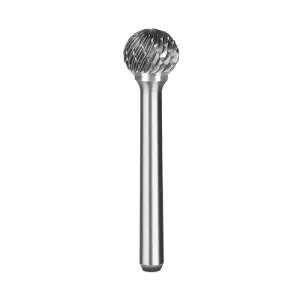In precision machining and material removal processes, Carbide Rotary Burs are valued for their hardness and cutting efficiency. However, like all cutting tools, they experience wear over time, which impacts performance and the quality of finished workpieces. Accurately determining the wear level of carbide rotary burs is essential to ensure timely maintenance or replacement, minimizing downtime, and avoiding poor machining results. This article outlines effective methods and signs to assess the wear condition of these critical tools.

Visual Inspection of Cutting Edges and Teeth
The simplest and most common way to judge the wear of carbide rotary burs is through careful visual inspection. Using magnification tools such as a loupe or microscope, operators can examine the cutting edges and teeth for signs of dullness, chipping, or rounding. Sharp burs have well-defined, crisp edges that cut efficiently, while worn burs show smooth or flattened edges, indicating material loss. Chips or cracks on the carbide surface also signal severe wear or damage. Consistent visual monitoring helps identify when burs no longer meet the sharpness standards required for precision work.
Monitoring Changes in Cutting Performance
Wear assessment can also be based on the observed performance of the bur during operation. As carbide rotary burs wear down, cutting efficiency decreases, leading to longer machining times and increased operator effort. Signs of declining performance include excessive vibration, rough or uneven surface finishes on the workpiece, and difficulty in cutting through materials that were previously handled smoothly. Additionally, worn burs may generate more heat, resulting in discoloration or burning marks on the workpiece. Tracking these performance changes allows operators to correlate tool condition with machining quality.
Measuring Dimensional and Geometric Accuracy
For more precise wear evaluation, dimensional measurements of the carbide rotary burs can be taken using tools like micrometers or coordinate measuring machines (CMM). Over time, the diameter and profile of the bur may change due to material erosion. Comparing current measurements with original specifications helps determine the degree of wear. Geometric deviations such as uneven tooth heights or distorted shapes are indicators that the bur’s cutting capability is compromised. This quantitative approach is particularly useful in high-precision manufacturing environments where tool consistency is critical.
Using Machine Data and Monitoring Systems
Advanced machining centers often provide integrated monitoring systems that can assist in wear detection. By analyzing parameters such as spindle load, cutting forces, vibration levels, and cycle times, operators can detect anomalies indicative of tool wear. A sudden increase in cutting force or vibration, for example, may suggest that the bur is dull or damaged. Some CNC machines also support tool life management software, which tracks usage data and estimates wear based on operating hours and cutting conditions. Utilizing machine data helps schedule timely bur replacements before quality deteriorates.
Maintenance Logs and Usage Tracking
Keeping detailed maintenance logs and usage records contributes to effective wear management of carbide rotary burs. By documenting operating hours, materials processed, cutting speeds, and previous wear assessments, operators can predict when a bur will likely reach its wear limit. This proactive approach avoids unexpected tool failure and supports consistent machining performance. Coupled with regular inspections, usage tracking forms part of a comprehensive tool management system.